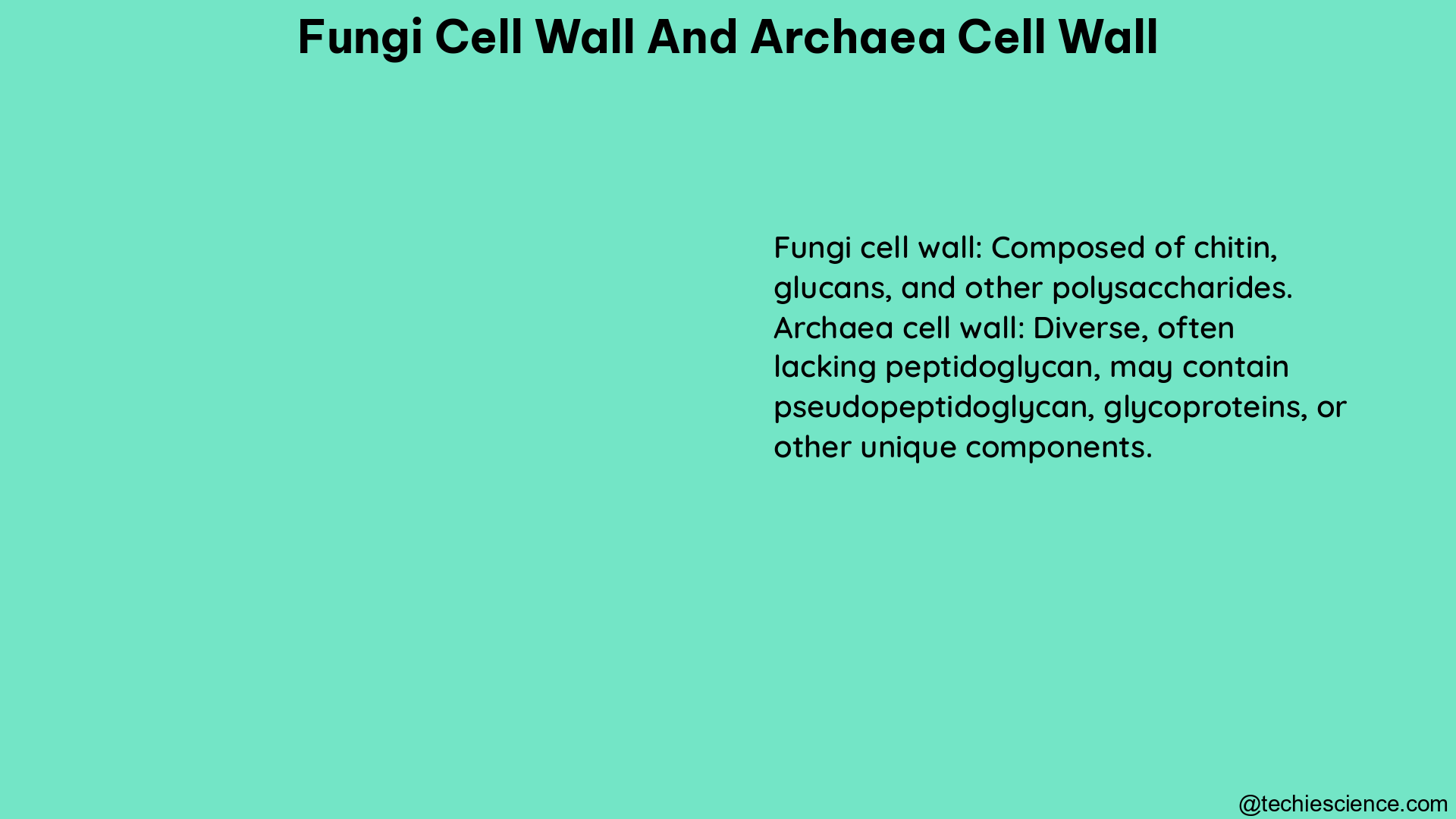The cell walls of fungi and archaea are intricate and fascinating structures, each with its unique composition and characteristics. These cell walls play a crucial role in the survival, adaptation, and function of these diverse organisms, making them a subject of great interest in the field of biology.
Fungal Cell Wall: A Chitin-Rich Fortress
Fungal cell walls are primarily composed of chitin, a polysaccharide made up of N-acetylglucosamine units. This chitin-rich structure provides fungi with a robust and protective barrier against environmental stresses, pathogens, and predators. In addition to chitin, fungal cell walls also contain other polysaccharides, such as glucans and mannans, as well as various proteins.
Quantifying Fungal Cell Wall Composition
One of the most effective techniques for analyzing the composition of fungal cell walls is solid-state nuclear magnetic resonance (ssNMR) spectroscopy. This powerful tool can provide detailed information on the polymorphic structure, composition, and physical packing of biomolecules within the native cell wall.
For instance, ssNMR analysis of the cell wall of the fungus Aspergillus sydowii has revealed that this species has a thickened, stiff, waterproof, and adhesive cell wall. This adaptation is particularly well-suited for growth in hypersaline environments, where the cell wall’s unique properties help the fungus thrive.
In addition to ssNMR, transmission electron microscopy (TEM) can also be used to measure the thickness and morphology of fungal cell walls. TEM imaging of A. sydowii mycelia grown under different conditions has shown that the cell wall thickness and structure can vary depending on the growth environment.
Fungal Cell Wall Diversity
The composition and structure of fungal cell walls can vary significantly among different species and even within the same species under different environmental conditions. This diversity reflects the remarkable adaptability of fungi to a wide range of habitats and ecological niches.
For example, the cell walls of pathogenic fungi, such as Candida albicans and Cryptococcus neoformans, have been extensively studied due to their importance in host-pathogen interactions and potential as targets for antifungal therapies. These studies have revealed unique cell wall features that contribute to the virulence and immune evasion strategies of these fungi.
Archaeal Cell Wall: A Mosaic of Biomolecules

In contrast to the chitin-based cell walls of fungi, archaeal cell walls are composed of a diverse array of materials, including pseudopeptidoglycan, glycoproteins, and polysaccharides. This mosaic-like structure is a testament to the remarkable evolutionary adaptations of archaea, which are known for their ability to thrive in some of the most extreme environments on Earth.
Quantifying Archaeal Cell Wall Composition
Researchers have employed various techniques to characterize the composition and structure of archaeal cell walls. One such approach is the use of multivariate statistics and indicator species analysis to identify potential biomarkers for specific archaeal groups.
For example, a recent study on archaeal necromass biomarkers identified talosaminuronic acid, a compound found in archaeal pseudopeptidoglycan, as a new potential biomarker for the Euryarchaeota, a major phylum of archaea. This discovery highlights the value of advanced analytical techniques in unveiling the unique features of archaeal cell walls.
Archaeal Cell Wall Diversity
The diversity of archaeal cell walls is a reflection of the remarkable adaptability and evolutionary success of this domain of life. Archaea are known to inhabit some of the most extreme environments on Earth, including high-temperature, high-salinity, and low-pH habitats.
To thrive in these challenging conditions, archaea have evolved a wide range of cell wall structures and compositions. For instance, the cell walls of halophilic archaea, which live in high-salt environments, often contain glycoproteins and polysaccharides that help maintain osmotic balance and protect the cells from desiccation.
Similarly, the cell walls of thermophilic archaea, which live in high-temperature environments, may contain unique lipids and other biomolecules that provide thermal stability and resistance to high temperatures.
Conclusion
The cell walls of fungi and archaea are complex and fascinating structures that continue to captivate the attention of biologists and researchers. Through the use of advanced analytical techniques, such as ssNMR, TEM, and multivariate statistics, we are gaining a deeper understanding of the composition, structure, and function of these organelles.
As we continue to explore the diversity and adaptability of fungal and archaeal cell walls, we may uncover new insights that have far-reaching implications for fields ranging from biotechnology and medicine to environmental science and astrobiology. By delving deeper into the intricacies of these cell walls, we can unlock the secrets of some of the most resilient and successful organisms on our planet.
References:
– Solid-state NMR spectroscopy reveals the polymorphic structure, composition, and physical packing of fungal cell walls
– Talosaminuronic acid as a new potential biomarker for Euryarchaeota in archaeal necromass
– Archaeal cell wall structure and function

Hi….I am Anushree Verma, I have completed my Master’s in Biotechnology. I am a very confident, dedicated and enthusiastic author from the biotechnology field. I have a good understanding of life sciences and great command over communication skills. I thrive to learn new things every day. I would like to thank this esteemed organization for giving me such a great opportunity.
Let’s connect through LinkedIn- https://www.linkedin.com/in/anushree-verma-066ba7153